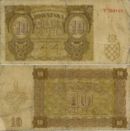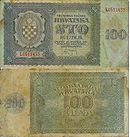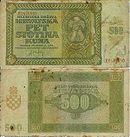
Independent State of Croatia kuna
Encyclopedia
The kuna was the currency
of the Independent State of Croatia
in the period between 1941 and 1945 during World War II
. The word "kuna" means "marten
" in Croatian
and the same word is used for the current Croatian kuna
currency. This kuna was subdivided into 100 banica. It was preceded and replaced by the Yugoslav dinar
.
(NDH) on 26 July 1941.
The kuna replace the Yugoslav dinar
at par and was fixed to the German Reichsmark
(RM) with dual exchange rates, one fixed at 20 kuna = 1 RM, the other a state-stimulated rate of
The kuna was withdrawn from circulation from 30 June to 9 July, 1945 and replaced by the 1944 issue of the Yugoslav dinar at a rate of 40 kuna = 1 dinar.
Kuna banknotes were introduced by the government in 1941, in denominations of 10, 50, 100, 500 and 1000 kuna. These were followed in 1942 by notes for 50 banicas and 1 and 2 kunas. In 1943, the Hrvatska Državna Banka (Croatian State Bank) introduced 100, 1000 and 5000 kuna notes. The notes were printed in Germany by Giesecke & Devrient
.
groups. These included the Zagreb
Government Region (Oblasni Narod. Oslobod. Odbor Zagrebačke Oblasti), the Croatian Anti-Fascist Authority (Zemaljsko Antifašističko Vijeće Hrvatske) and the Croatian Anti-Fascist Government Authority ZAVNOH (Zemaljsko Antifašističko Vijeće Narodnog Oslobodenja Hrvatske).
The Zagreb Government Region issued notes for 500, 1000, 5000, 10,000 and 50,000 kunas. The Croatian Anti-Fascist Authority and Croatian Anti-Fascist Government Authority issued notes in 1943, denominated in both dinars and kunas, for 100, 500, 1000, 5000, 10,000 and 100,000 kunas/dinars. Notes for 100, 500 and 1000 liras were also issued without indication as to the value in kunas.
Currency
In economics, currency refers to a generally accepted medium of exchange. These are usually the coins and banknotes of a particular government, which comprise the physical aspects of a nation's money supply...
of the Independent State of Croatia
Independent State of Croatia
The Independent State of Croatia was a World War II puppet state of Nazi Germany, established on a part of Axis-occupied Yugoslavia. The NDH was founded on 10 April 1941, after the invasion of Yugoslavia by the Axis powers. All of Bosnia and Herzegovina was annexed to NDH, together with some parts...
in the period between 1941 and 1945 during World War II
World War II
World War II, or the Second World War , was a global conflict lasting from 1939 to 1945, involving most of the world's nations—including all of the great powers—eventually forming two opposing military alliances: the Allies and the Axis...
. The word "kuna" means "marten
Marten
The martens constitute the genus Martes within the subfamily Mustelinae, in family Mustelidae.-Description:Martens are slender, agile animals, adapted to living in taigas, and are found in coniferous and northern deciduous forests across the northern hemisphere. They have bushy tails, and large...
" in Croatian
Croatian language
Croatian is the collective name for the standard language and dialects spoken by Croats, principally in Croatia, Bosnia and Herzegovina, the Serbian province of Vojvodina and other neighbouring countries...
and the same word is used for the current Croatian kuna
Croatian kuna
The kuna is the currency of Croatia since 1994 . It is subdivided into 100 lipa. The kuna is issued by the Croatian National Bank and the coins are minted by the Croatian Monetary Institute....
currency. This kuna was subdivided into 100 banica. It was preceded and replaced by the Yugoslav dinar
Yugoslav dinar
The dinar was the currency of the three Yugoslav states: the Kingdom of Yugoslavia , the Socialist Federal Republic of Yugoslavia and the Federal Republic of Yugoslavia between 1918 and 2003. The dinar was subdivided into 100 para...
.
History
The Croatian kuna was introduced in the Independent State of CroatiaIndependent State of Croatia
The Independent State of Croatia was a World War II puppet state of Nazi Germany, established on a part of Axis-occupied Yugoslavia. The NDH was founded on 10 April 1941, after the invasion of Yugoslavia by the Axis powers. All of Bosnia and Herzegovina was annexed to NDH, together with some parts...
(NDH) on 26 July 1941.
The kuna replace the Yugoslav dinar
Yugoslav dinar
The dinar was the currency of the three Yugoslav states: the Kingdom of Yugoslavia , the Socialist Federal Republic of Yugoslavia and the Federal Republic of Yugoslavia between 1918 and 2003. The dinar was subdivided into 100 para...
at par and was fixed to the German Reichsmark
German reichsmark
The Reichsmark was the currency in Germany from 1924 until June 20, 1948. The Reichsmark was subdivided into 100 Reichspfennig.-History:...
(RM) with dual exchange rates, one fixed at 20 kuna = 1 RM, the other a state-stimulated rate of
- 31 December 1941 - 25.00 Kn = 1 RM
- 31 December 1942 - 37.50 Kn = 1 RM
- 31 December 1943 - 40.00 Kn = 1 RM
- 31 December 1944 - 80.00 Kn = 1 RM
- 6 May 1945 - 120.00 Kn = 1 RM
The kuna was withdrawn from circulation from 30 June to 9 July, 1945 and replaced by the 1944 issue of the Yugoslav dinar at a rate of 40 kuna = 1 dinar.
Coins
Zinc coins were issued in denominations of 1 and 2 kune in 1941, but only the 2 kune pieces are available today in appreciable numbers.Banknotes
 |
 |
 |
Kuna banknotes were introduced by the government in 1941, in denominations of 10, 50, 100, 500 and 1000 kuna. These were followed in 1942 by notes for 50 banicas and 1 and 2 kunas. In 1943, the Hrvatska Državna Banka (Croatian State Bank) introduced 100, 1000 and 5000 kuna notes. The notes were printed in Germany by Giesecke & Devrient
Giesecke & Devrient
Giesecke & Devrient is a German company headquartered in Munich that provides banknote and securities printing, smart cards, and cash handling systems....
.
Competing issues
Notes were also issued by partisanPartisans (Yugoslavia)
The Yugoslav Partisans, or simply the Partisans were a Communist-led World War II anti-fascist resistance movement in Yugoslavia...
groups. These included the Zagreb
Zagreb
Zagreb is the capital and the largest city of the Republic of Croatia. It is in the northwest of the country, along the Sava river, at the southern slopes of the Medvednica mountain. Zagreb lies at an elevation of approximately above sea level. According to the last official census, Zagreb's city...
Government Region (Oblasni Narod. Oslobod. Odbor Zagrebačke Oblasti), the Croatian Anti-Fascist Authority (Zemaljsko Antifašističko Vijeće Hrvatske) and the Croatian Anti-Fascist Government Authority ZAVNOH (Zemaljsko Antifašističko Vijeće Narodnog Oslobodenja Hrvatske).
The Zagreb Government Region issued notes for 500, 1000, 5000, 10,000 and 50,000 kunas. The Croatian Anti-Fascist Authority and Croatian Anti-Fascist Government Authority issued notes in 1943, denominated in both dinars and kunas, for 100, 500, 1000, 5000, 10,000 and 100,000 kunas/dinars. Notes for 100, 500 and 1000 liras were also issued without indication as to the value in kunas.

